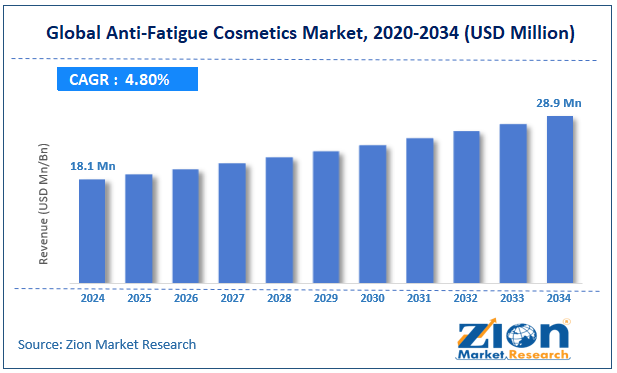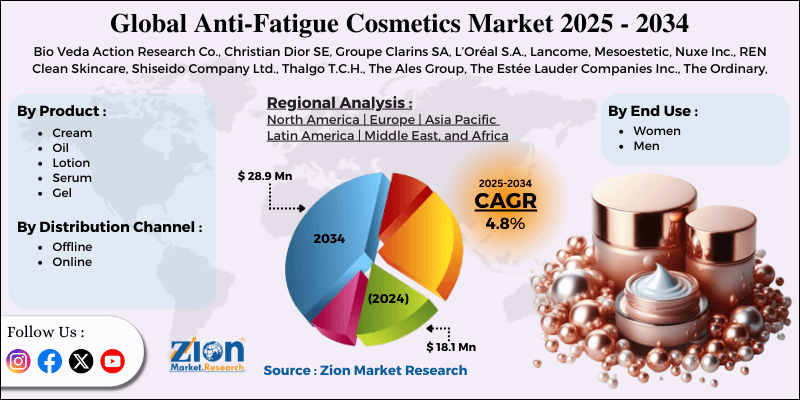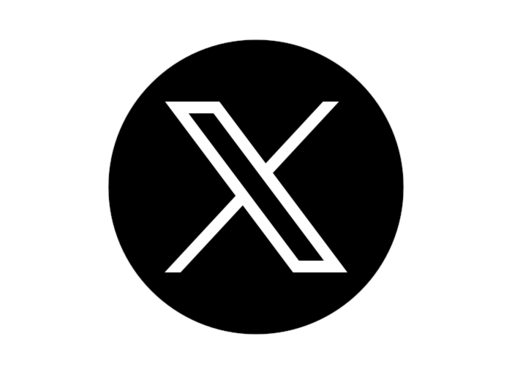Anti-Fatigue Cosmetics Market Size, Share, Trends, Growth and Forecast 2034

Anti-Fatigue Cosmetics Market By Product (Cream, Oil, Lotion, Serum, Gel, and Others), By End Use (Women and Men), By Distribution Channel (Offline and Online), and By Region - Global and Regional Industry Overview, Market Intelligence, Comprehensive Analysis, Historical Data, and Forecasts 2025 - 2034
| Market Size in 2024 | Market Forecast in 2034 | CAGR (in %) | Base Year |
|---|---|---|---|
| USD 18.1 Million | USD 28.9 Million | 4.8% | 2024 |
Anti-Fatigue Cosmetics Industry Prospective:
The global anti-fatigue cosmetics market size was worth around USD 18.1 million in 2024 and is predicted to grow to around USD 28.9 million by 2034, with a compound annual growth rate (CAGR) of roughly 4.8% between 2025 and 2034.
Anti-Fatigue Cosmetics Market: Overview
Anti-fatigue cosmetics are skincare and cosmetic items that fight dull skin, dark circles, puffiness, and fine wrinkles—signs of tiredness. These products hydrate the skin, boost circulation, and revitalize it to give it a more youthful, fresh appearance.
Face masks, eye creams, serums, BB creams, and foundations with skincare advantages all feature these cosmetics. Demand for anti-fatigue cosmetics has grown as understanding of the advantages of skincare, especially among urban consumers who must deal with stress and pollution, becomes more widespread.
Key Insights
- As per the analysis shared by our research analyst, the global anti-fatigue cosmetics market is estimated to grow annually at a CAGR of around 4.8% over the forecast period (2025-2034).
- In terms of revenue, the global anti-fatigue cosmetics market size was valued at around USD 18.1 million in 2024 and is projected to reach USD 28.9 million by 2034.
- The growing urbanization and busy lifestyles are expected to drive the anti-fatigue cosmetics market over the forecast period.
- Based on the product, the cream segment is expected to hold the largest market share over the forecast period.
- Based on its end use, the women segment is expected to dominate the market expansion over the projected period.
- Based on its distribution channel, the offline segment is expected to capture the highest revenue share over the projected period.
- Based on region, North America is expected to dominate the market during the forecast period.
Anti-Fatigue Cosmetics Market: Growth Drivers
Growing urbanization & busy lifestyles drive market growth
Growing urbanization and busy lives drive the anti-fatigue cosmetics market since more people search for solutions to environmental damage, stress, and tiredness that affect their skin. Urban populations' greater stress levels, irregular sleep patterns, and long workdays, which can cause puffiness, dark circles, and dull skin, are driving demand for anti-fatigue skincare products.
Because air pollution, UV radiation, and blue light from screens all contribute to oxidative stress, skin tiredness, and early aging, consumers hunt for antioxidant-rich skincare products such as vitamin C serums, detox masks, and caffeine-infused creams.
Anti-Fatigue Cosmetics Market: Restraints
High product costs hinder market growth
One of the key challenges hindering the expansion of the anti-fatigue cosmetics industry is the high cost of goods, which might influence accessibility and adoption rates, especially in price-sensitive areas. Many anti-fatigue cosmetics are positioned as luxury or high-end products, targeted at wealthy consumers ready to spend money on upscale skincare.
Luxury branding drives higher price strategies to retain perceived value and uniqueness. Anti-fatigue cosmetics also boost sales using influencer marketing, celebrity sponsorships, and online campaigns. High marketing budgets translate into increased product pricing to pay for promotional costs. Thus, the aforementioned reason negatively impacted the revenue expansion.
Anti-Fatigue Cosmetics Market: Opportunities
Growing innovative product launches offer a lucrative opportunity for market growth
The increasing launch of innovative solutions in the anti-fatigue cosmetics sector offers a lucrative opportunity for revenue growth over the analysis period.
For instance, in March 2024, MelasylTM, a revolutionary chemical created to address specialized pigmentation disorders that result in age spots and post-acne marks, was introduced by L'Oréal Groupe. Half of all persons report having at least one skin pigmentation problem, according to a groundbreaking global epidemiological study on pigmentary disorders.
All skin tones can benefit from the new unique component in L'Oréal formulations that target pigmented skin blemishes and enhance their look. Melasyl is the outcome of 121 scientific investigations and extensive testing.
Even the most stubborn blemishes can be addressed with cosmetics made with multi-patented Melasyl, which helps to create a more even, natural skin tone.
Melasyl, which is now offered in La Roche Posay's Mela B3 franchise, which includes MelaB3 serum and MelaB3 SPF30, is the result of 18 years of research. Future product launches by L'Oréal Paris and Vichy will increase consumer access to professional formulations incorporating the novel component.
Anti-Fatigue Cosmetics Market: Challenges
Regulatory and safety concern poses a major challenge to market expansion
Product introductions in North America and Europe may be slowed by stringent laws governing skincare claims, ingredients, and labeling. Active substances (such as retinol, caffeine, or specific preservatives) may cause allergic reactions or skin irritation, resulting in product recalls or legal problems. Therefore, the regulatory and safety concerns pose a major challenge to the anti-fatigue cosmetics market expansion.
Anti-Fatigue Cosmetics Market: Report Scope
| Report Attributes | Report Details |
|---|---|
| Report Name | Anti-Fatigue Cosmetics Market |
| Market Size in 2024 | USD 18.1 Million |
| Market Forecast in 2034 | USD 28.9 Million |
| Growth Rate | CAGR of 4.8% |
| Number of Pages | 211 |
| Key Companies Covered | Bio Veda Action Research Co., Christian Dior SE, Groupe Clarins SA, L’Oréal S.A., Lancome, Mesoestetic, Nuxe Inc., REN Clean Skincare, Shiseido Company Ltd., Thalgo T.C.H., The Ales Group, The Estée Lauder Companies Inc., The Ordinary, and others. |
| Segments Covered | By Product, By End Use, By Distribution Channel, and By Region |
| Regions Covered | North America, Europe, Asia Pacific (APAC), Latin America, Middle East, and Africa (MEA) |
| Base Year | 2024 |
| Historical Year | 2019 to 2023 |
| Forecast Year | 2025 - 2034 |
| Customization Scope | Avail customized purchase options to meet your exact research needs. Request For Customization |
Anti-Fatigue Cosmetics Market: Segmentation
The global anti-fatigue cosmetics industry is segmented based on product, end use, distribution channel, and region.
Based on the product, the global market is bifurcated into cream, oil, lotion, serum, gel, and others. The cream segment is expected to hold the largest market share over the forecast period. Growing awareness of the use of cosmetics and body care products helps this market to flourish. Due to constant innovation and the launch of fresh products in this market, consumers have an extensive selection of options.
Furthermore, there is a high revenue increase in the anti-fatigue cosmetics market due to purchasers' readiness to spend more money on luxury cosmetics, particularly makeup lines and daily beauty products.
Based on end use, the global anti-fatigue cosmetics industry is bifurcated into women and men. The women segment is expected to dominate the market expansion over the projected period. Cosmetics use is typically higher among women than among men.
Growing awareness of skin health, attractiveness, and personal cleanliness is what propels this market's expansion. Self-care routines, the use of natural or organic products, and the use of anti-fatigue cosmetics have become more common as a result of the growing awareness of the need to keep healthy skin and self-care.
Based on distribution channel, the global anti-fatigue cosmetics market is bifurcated into offline and online. The offline segment is expected to capture the highest revenue share over the projected period. The segment expansion is owing to the wide availability of cosmetic products from different brands.
Anti-Fatigue Cosmetics Market: Regional Analysis
North America dominates the market over the projected period
North America is expected to dominate the global anti-fatigue cosmetics market. The demand for anti-fatigue products has increased in the area due to the availability of several well-known brands, accessibility through offline and online channels, and alluring discounts and offers from businesses and merchants.
Additionally, the expansion of this regional industry has been fueled by increased awareness of personal care and the importance of skin health.
Besides, the Asia Pacific is expected to grow at a rapid rate during the projected period, owing to the increasing rate of urbanization, especially in countries like India and China. Moreover, the growth in the e-commerce sector and innovative product launches drive the industry growth in the region.
Anti-Fatigue Cosmetics Market: Competitive Analysis
The global anti-fatigue cosmetics market is dominated by players like:
- Bio Veda Action Research Co.
- Christian Dior SE
- Groupe Clarins SA
- L’Oréal S.A.
- Lancome
- Mesoestetic
- Nuxe Inc.
- REN Clean Skincare
- Shiseido Company Ltd.
- Thalgo T.C.H.
- The Ales Group
- The Estée Lauder Companies Inc.
- The Ordinary
The global anti-fatigue cosmetics market is segmented as follows:
By Product
- Cream
- Oil
- Lotion
- Serum
- Gel
- Others
By End Use
- Women
- Men
By Distribution Channel
- Offline
- Online
By Region
- North America
- The U.S.
- Canada
- Europe
- France
- The UK
- Spain
- Germany
- Italy
- Rest of Europe
- Asia Pacific
- China
- Japan
- India
- South Korea
- Southeast Asia
- Rest of Asia Pacific
- Latin America
- Brazil
- Mexico
- Rest of Latin America
- Middle East & Africa
- GCC
- South Africa
- Rest of Middle East & Africa
Table Of Content
Methodology
FrequentlyAsked Questions
Anti-fatigue cosmetics are skincare and cosmetic items meant to fight dull skin, dark circles, puffiness, and fine wrinkles—signs of tiredness.
The anti-fatigue cosmetics market is driven by several variables, including growing urbanization, increasing product innovation, influence of social media & beauty trends, rising demand for natural & clean beauty products, and many others.
According to the report, the global anti-fatigue cosmetics market size was worth around USD 18.1 million in 2024 and is predicted to grow to around USD 28.9 million by 2034.
The global anti-fatigue cosmetics market is expected to grow at a CAGR of 4.8% during the forecast period.
The global anti-fatigue cosmetics market growth is expected to be driven by North America. It is currently the world’s highest revenue-generating market due to the growing innovative product launches and expansion of e-commerce & DTC (Direct-to-Consumer) brands.
The global anti-fatigue cosmetics market is dominated by players like Bio Veda Action Research Co., Christian Dior SE, Groupe Clarins SA, L’Oréal S.A., Lancome, Mesoestetic, Nuxe, Inc., REN Clean Skincare, Shiseido Company Ltd., Thalgo T.C.H., The Ales Group, The Estée Lauder Companies Inc., and The Ordinary, among others.
The anti-fatigue cosmetics market report covers the geographical market along with a comprehensive competitive landscape analysis. It also includes cash flow analysis, profit ratio analysis, market basket analysis, market attractiveness analysis, sentiment analysis, PESTLE analysis, trend analysis, SWOT analysis, trade area analysis, demand & supply analysis, Porter’s five forces analysis, and value chain analysis.
HappyClients
Zion Market Research
Tel: +1 (302) 444-0166
USA/Canada Toll Free No.+1 (855) 465-4651
3rd Floor,
Mrunal Paradise, Opp Maharaja Hotel,
Pimple Gurav, Pune 411061,
Maharashtra, India
Phone No +91 7768 006 007, +91 7768 006 008
US OFFICE NO +1 (302) 444-0166
US/CAN TOLL FREE +1 (855) 465-4651
Email: sales@zionmarketresearch.com
We have secured system to process your transaction.
Our support available to help you 24 hours a day, five days a week.
Monday - Friday: 9AM - 6PM
Saturday - Sunday: Closed







